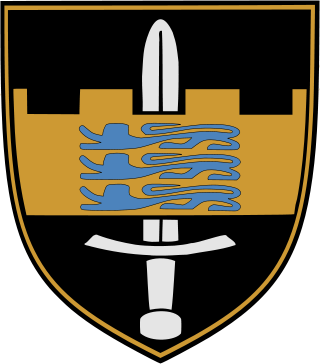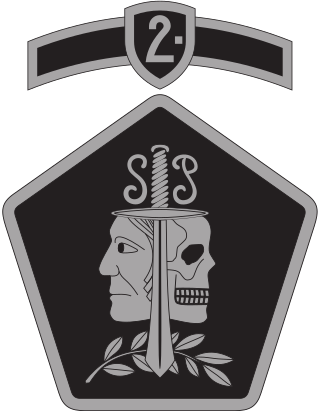
Harju County, is one of the fifteen counties of Estonia. It is situated in northern Estonia, on the southern coast of the Gulf of Finland, and borders Lääne-Viru County to the east, Järva County to the southeast, Rapla County to the south, and Lääne County to the southwest. The capital and largest city of Estonia, Tallinn, is situated in Harju County. Harju is the largest county in Estonia in terms of population, as almost half (45%) of Estonia's population lives in Harju County.

Paldiski is a town and Baltic Sea port located on the Pakri Peninsula in northwestern Estonia. Originally established as a small Swedish port known as Rågervik, it evolved into an important ice-free port upon being incorporated into the Russian Empire in the 18th century.

The Estonian Navy are the unified naval forces among the Estonian Defence Forces.

The Estonian Air Force is the aviation branch of the Estonian Defence Forces. The air force traces its history to 1918, and was re-established in its current form in 1991.

The Estonian Land Forces, unofficially referred to as the Estonian Army, is the name of the unified ground forces among the Estonian Defense Forces where it has an offensive military formation role. The Estonian Land Forces is currently the largest Estonian military branch, with an average size of approximately 6,000 soldiers, conscripts, and officers during peacetime.

15th Artillery Battalion of the 1st Infantry Brigade, formerly the Artillery Group, is an artillery battalion of the Estonian Defence Forces, based out of Tapa Army Base. The unit is part of the Estonian Land Forces. It is tasked with supporting combat units with indirect fire during war-time.

Engineer Battalion is a combat engineering battalion of the Estonian Defence Forces, based out of Tapa Army Base. The unit falls under the command of 1st Infantry Brigade of Estonian Land Forces.

The 1st Infantry Brigade is an infantry brigade of the Estonian Land Forces. It is the primary military unit in Northern Estonia. The brigade headquarters is based at Tapa.

The Estonian Border Guard was the national security agency responsible for the border security of Estonia. It was subordinate to the Ministry of the Interior. The Border Guard also assisted with Search and Rescue missions. In 2010, the organization was superseded by the Police and Border Guard Board.

The Estonian Defence Forces is the unified military force of the Republic of Estonia. The Estonian Defence Forces consists of the Estonian Land Forces, the Estonian Navy, the Estonian Air Force, and the paramilitary Estonian Defence League. The national defence policy aims to guarantee the preservation of the independence and sovereignty of the state and maintain the integrity of its land area, territorial waters, airspace, and constitutional order. Its main goals remain the development and maintenance of a credible capability to defend the nation's vital interests and of the defence forces in a way that ensures their interoperability with the armed forces of NATO and European Union member states in order to participate in the full range of missions for these military alliances.

The Military Police of the Estonian Defence Forces is the military police unit of the Estonian Defence Forces. The Estonian military police organization was created in 1994 and its structure includes an investigative department, planning department, logistics department, operational service and the office of the military police. Additionally conscript based reserve- MP platoons are trained every year in Guard Battalion, which is subordinate to the military police. The tasks of the military police include: investigation of serious disciplinary cases and some armed service- related crimes, supervision of military discipline within the Forces, military traffic control and various security tasks. Within conflict/crises areas (Afghanistan) the MP may provide close protection of the Estonian national representative and other visiting VIPs.
Jägala Army Base is a former military base of the Estonian Defence Forces in Jägala village in Jõelähtme Parish, Harju County, Estonia. The base is located about 25 kilometres to the east of Tallinn.

The Logistics Battalion is the main central unit of the Support Command of the Estonian Defence Forces which provides various logistical support. This battalion has a logistical role in the Estonian Defence Forces along with Combat Service Support Battalions of the Infantry Brigades of Estonian Land Forces.

The Life Guard Dragoons, designated K 1, was a Swedish Army cavalry unit active from 1949 to 2000. The unit was formed as a squadron called the Life Guards Squadron (Livgardesskvadronen) in 1949, as a replacement for the previous K 1, the Life Regiment of Horse (1928–1948). In 1975 the squadron were made into a regiment, titled the Life Guard Dragoons with Stockholm Defence District, redesignated the Life Guard Dragoons in 1984. The regiment had ceremonial mounted cavalry duties, as well as training recruits and providing part of the garrison in Stockholm. In accordance with that year's Defence Act, the regiment was amalgamated into the Life Guards in 2000, thus combining the infantry and cavalry guard units of the Swedish Army.

The Kalev Infantry Battalion is an infantry battalion of the Estonian Land Forces. It is a part of the 1st Infantry Brigade and its primary task is to train conscription-based mechanized infantry units. The battalion has been previously known as the Kalevlaste Maleva and as the Kalev Single Infantry Battalion. The battalion is currently based at Jõhvi.

The Viru Infantry Battalion is a battalion of the Estonian Land Forces. It is a part of the 1st Infantry Brigade and its primary task is to train conscription-based infantry and anti-tank units. The battalion has been previously known as the 4th Infantry Regiment and as the 4th Single Infantry Battalion. The battalion is currently based at Jõhvi.

The 2nd Infantry Brigade is an infantry brigade of the Estonian Land Forces. It is the primary military unit in Southern Estonia. The brigade headquarters is currently based at Sirgu village, Luunja Parish, Tartu County. The brigade is tasked with planning and organizing military operations, planning and organizing mobilization, ensuring the readiness and support of its subordinate units, preparing wartime reserve units and their formation, organizing the training and participation in international military operations.

The Kaitseväe orkester, known in Anglophone countries as the Band of the Estonian Defence Forces, is the official military band service of the Estonian Defence Forces. The main task of the band is to play music at all national and military ceremonies. The band's repertoire includes mostly classical and marching music. It is currently made up of 40 musicians. From 1996 to 2019, the conductor of the band was Lieutenant Colonel Peeter Saan. Each year, the band takes part in about 220 concerts, festivals, and ceremonial parades of the Defence Forces. It has also performed at venues abroad in countries like Lithuania, France and Germany. Traditionally, the band holds Autumn and Spring concerts in the Estonia Concert Hall.

Riho Ühtegi is an Estonian major general. He has been the Commander of the Estonian Special Operations Force. Since 2019, he is the commander of the Estonian Defence League.

Veiko-Vello Palm is a retired Estonian Major General of the Estonian Defence Forces. He commanded the Estonian Division from 2023 until his retirement in 2024.



























